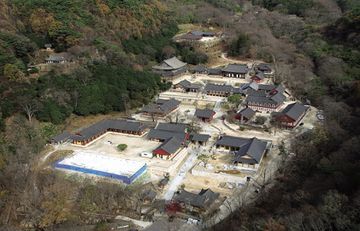구례 화엄사(종합안내판)
| 구례 화엄사 Hwaeomsa Temple, Gurye |
|
 구례 화엄사, 국가문화유산포털, 문화재청. |
|
| 대표명칭 | 구례 화엄사 |
|---|---|
| 영문명칭 | Hwaeomsa Temple, Gurye |
| 한자 | 求禮 華嚴寺 |
| 주소 | 전라남도 구례군 마산면 화엄사로 539 |
|
|
|
해설문
국문
화엄사는 백제 성왕 22년(544년)에 인도에서 온 연기존자(鷰起尊者)에 의해 창건했으며 절 이름을 화엄경(華嚴經)의 두 가지를 따서 화엄사라 하고, 지리산은 문수보살님이 계신 산이라서 대지문수사리보살(大智文殊師利菩薩)의 이름을 택하여 두류산에서 지리산(智利山)이라 하여 지리산화엄사(智利山華嚴寺)가 창건 되었다.
이후 자장법사와 원효성사, 의상대사, 도선국사, 의천 등 여러 고승에 의해 중창되어 조선 세종 6년(1424년)에는 선종대본산(禪宗大本山)으로 승격되기도 하였다. 정유재란 때 주지였던 설홍대사는 군량 103석으로 153명의 승병을 거느리고 석주진(石柱鎭)을 고수하다가 장렬히 전사하고 또한 대가람인 8원 81암자가 전소 되었다. 벽암각성대사는 인조 8년(1630년)에 동서오층석탑 중수와 더불어 화엄사 중건을 시작하여 대웅전을 비롯해 몇몇 법당, 전각을 중창하였으며 인조 14년(1636년)에 끝맺었다. 계파당 성능(桂坡堂 性能)대사가 각황전 중건을 숙종 25년(1699년)에 시작하여 숙종 29년(1703년)에 중건 불사를 회향하자 선교양종대가람(禪敎兩宗大伽藍)으로 승격 되었다.
일주문, 금강문, 천왕문을 차례로 지나 보제루 앞마당에 들어서면 높이 쌓아 올린 대석단을 중심으로 아래로는 승방과 강원등의 수행공간이 위로는 대웅전과 각황전을 비롯한 예불공간이 자리 잡고 있다. 눈여겨볼 것은 각황전과 대웅전 중심으로 절묘하게 조화된 가람배치의 아름다움이다.
4사자 3층석탑과 공양탑이 있어 연기존자와 어머니의 이야기가 서려 있는 효대, 원통전 앞에 구례 화엄사 원통전 앞 사자탑(4사자 감로탑)과 각황전 앞의 화엄석등, 동서석탑, 그리고 대웅전 뒤편 숲속의 오솔길을 따라 오르면 천불전과 모과나무 기둥이 독특한 구층암 등도 화엄사에서 빼놓을 수 없는 볼거리들이다.
영문
Hwaeomsa Temple, Gurye
Hwaeomsa Temple is said to have been founded in 544 by an eminent Indian monk known as Yeongi in Korean. The name of the temple comes from the Avatamsaka Sutra (The Flower Garland Sutra), called Hwaeomgyeong in Korean, which is one of the most influential scriptures in East Asian Buddhism.
During the Silla period (57 BCE-935 CE) and later in the Goryeo period (918-1392), the temple was renovated and expanded by a number of prominent Korean monks such as Jajang (590-658), Uisang (625-702), Doseon (827-898), and Uicheon (1055-1101). In 1424, during the Joseon period (1392-1910), it was designated as the main temple of the Meditative School of Buddhism, but was burnt down during the Japanese invasions of 1592-1598.
From 1630 to 1636, a number of the temple's buildings including Daeungjeon Hall were rebuilt by the monk Byeogam (1575-1660). In 1702, the monk Seongneung built Gakhwangjeon Hall and King Sukjong (r. 1674-1720) bestowed the building its name. More recently, Ven. Dogwang (1922-1984), who was appointed head monk in 1969, oversaw additional repairs and renovations of the temple.
To enter the main temple area, one must pass through three gates to prepare one's mind and heart. These gates, called Burimun, Geumgangmun, and Cheonwangmun respectively symbolize a single mind, the protection of the Buddhist teachings, and the repulsion of evil spirits. There is then a courtyard surrounded with monastic buildings relating to the teaching of Buddhist scriptures and the practice of meditation, such as Bojeru Pavilion and the monks' living quarters. After passing the pavilion, one enters the main courtyard, which is a sacred area of worship. This courtyard is flanked by the two main worship halls of the temple, namely Daeungjeon Hall and Gakhwangjeon Hall, which enshrine Vairocana Buddha and Sakyamuni Buddha as their main buddhas, respectively. The main courtyard also features a pair of five-story stone pagodas and the largest extant stone lantern in Korea. On the hill behind the Gakhwangjeon Hall, there is a three-story stone pagoda with four lions statues that relates to the myth of the founder monk Yeongi.
In December 2009, Hwaeomsa Temple and its surroundings were designated as Scenic Site No. 64 due to the beautiful natural scenery and the way the Buddhist heritages harmonize with the landscape of Jirisan Mountain. In the same month, the temple was also designated as Historic Site No. 505, due to its historical significance, its influence over Korean Buddhism, and its symbolic relation to the Flower Garland Sutra.
영문 해설 내용
화엄사는 544년 인도에서 온 연기존자가 창건했다고 전해진다. 절 이름은 동아시아 불교사에서 가장 큰 영향을 미친 불교 경전 중 하나인 『화엄경』에서 비롯되었다.
신라시대부터 고려시대에 이르기까지 자장(590-658), 의상(625-702), 도선(827-898), 의천(1055-1101) 등 한국의 여러 이름난 승려들이 중창을 거듭하면서 대규모의 사찰로 자리 잡았다. 조선시대인 1424년에는 선종대본산으로 승격되었으나, 임진왜란 때 전소되는 아픔을 겪었다.
이후 1630년부터 1636년까지 벽암대사(1575-1660)가 대웅전을 비롯한 여러 전각을 재건하였다. 1702년에는 성능대사가 각황전을 재건하였으며, 당시 임금이었던 숙종(재위 1674-1720)이 전각의 이름과 내려주었다. 현대에 이르러 1969년 주지로 부임한 도광(1922~1984) 스님의 전면적인 중수로 현재의 모습이 되었다.
사찰로 들어갈 때는 세 개의 문을 차례로 지나며 마음가짐을 준비하게 된다. 불이문, 금강문, 천왕문으로 불리는 이 문들은 각각 마음을 하나로 모으고, 불법의 수호하며, 악귀를 물리친다는 의미를 담고 있다. 마당에 들어서면 스님들이 머무르며 수행하는 공간이 있고, 보제루를 지나면 주요 전각이 위치한 예불공간이 자리하고 있다. 예불공간에는 비로자나불을 모신 대웅전과 석가모니불을 모신 각황전이 있고, 동·서오층석탑과 한국 최대의 석등도 있다. 각황전 뒤 언덕 위에는 연기존자의 설화가 전해지는 사사자 삼층석탑이 있다.
2009년 12월, 지리산에 자리한 사찰과 암자의 건물들이 주변의 자연 경관과 아름다운 조화를 이루어, 화엄사와 그 일원이 명승 제64호로 지정되었다. 같은 달, 화엄사는 그 역사성, 한국 불교에 끼친 영향, 화엄사상의 상징성 등을 인정 받아 사적 제505호로 지정되었다.